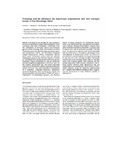Please use this identifier to cite or link to this item:
http://hdl.handle.net/10311/294| Title: | Flooding and its influence on diazotroph populations and soil nitrogen levels in the Okavango Delta |
| Authors: | Omari, K. Mubyana, T. Matsheka, M.I. Bonyongo, M.C. Veenendaal, E. |
| Keywords: | Diazotrophs rhizosphere Restriction Fragment Length Polymorphism |
| Issue Date: | 2004 |
| Publisher: | South African Journal of Botany http://www.elsevier.com/wps/find/journaldescription.cws_home/707238/description#description |
| Citation: | Omari, K. et al (2004) Flooding and its influence on diazotroph populations and soil nitrogen levels in the Okavango Delta, vol. 70, no. 5, pp. 734–740 |
| Abstract: | Effects of flooding on soil nitrogen (N), and asymbiotic nitrogen fixing bacterial (diazotroph) populations of the Okavango Delta were investigated. Diazotrophs from the rhizosphere of dominant annual and perennial grasses of the Okavango Delta were isolated on N-free composite media and identified applying morphological and biochemical criteria and Restriction Fragment Length Polymorphism (RFLP). Azotobacter species were found associated mostly with the grasses Andropogon guyanus and Vetevaria nigritiana (103CFU g–1 rhizosphere soil). Annual grasses such as Eragrostis inamoena, Setaria sphacelata as well as perennials showed insignificant populations (<101CFU g–1 soil). On the contrary, Azospirillum spp. was found associated with most of the grasses. Highest population densities (above 104MPN g–1 soil) were observed in rhizospheres of E. inamoena, Cympogon excavatus, Sporobolus acinifolis, Eragrostis lapila and Eragrostis rigidor and lowest population densities (below 102MPN g–1 soil) in rhizospheres of Andropogon guyanus and Panicum repens. Flooding increased the Azotobacter populations, while Azospirillum spp. populations were significantly reduced. Nitrogen-fixing sulphur reducers were observed in the rhizosphere of annuals (A. guyanus and P. repens) and only in perennials growing in flooded soils. No Beijerinckia species were found associated with any of the grasses. The highest soil nitrogen levels were detected in flooded soils (<0.20% N) while no N was detected in the rhizosphere soil of grasses growing in very dry soils (<5% moisture content). The results indicate that in the Okavango Delta, total soil nitrogen varies with flooding regime. With flooding, the diazotroph population shifts towards Azotobacter and Nfixing sulphur reducers while Azospirillum spp. are widespread in non-flooded soils. RFLP analysis of the 1 450bp amplicon using the restriction endonuclease Alu1, showed three different banding profiles, suggesting the occurrence of three different species of Azospirillum. |
| URI: | http://hdl.handle.net/10311/294 |
| ISSN: | 0254-6299 |
| Appears in Collections: | Research articles (Dept of Biological Sciences) Research articles (ORI) |
Files in This Item:
| File | Description | Size | Format | |
|---|---|---|---|---|
| Flooding and its influence.pdf | 2.2 MB | Adobe PDF |  View/Open |
Items in DSpace are protected by copyright, with all rights reserved, unless otherwise indicated.
